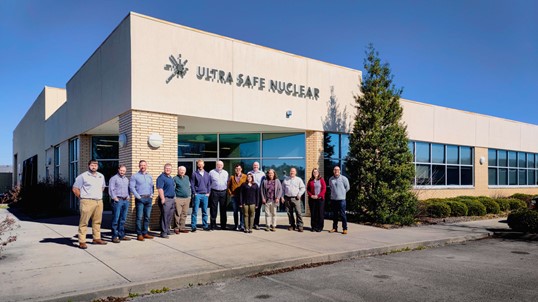Artist’s conception of a site for the Rolls-Royce small modular reactor. (Image: Rolls-Royce)
The United Kingdom’s Department of Business, Energy and Industrial Strategy (BEIS) has asked regulators—including the U.K. Office for Nuclear Regulation (ONR), the Environment Agency, and Natural Resources Wales—to begin a generic design assessment (GDA) of Rolls-Royce SMR’s 470-MWe small modular reactor design.
The Karachi nuclear plant, on the Arabian Sea coast in Pakistan. (Photo: CNNC)
Unit 3 at Pakistan’s Karachi nuclear power plant has been connected to the national grid, China National Nuclear Corporation (CNNC) announced on March 4, making it the second Hualong One reactor outside of China to have reached the last major step prior to commercial operation. (The distinction of being the first belongs to Unit 3’s twin, Karachi-2, which was connected to the grid in March 2021 and entered commercial operation in May.)
Karachi-3 had achieved criticality on February 21 after completing hot functional testing and entering the fuel loading stage last November.
Ultra Safe Nuclear staff in front of the new pilot fuel fabrication facility in Oak Ridge, Tenn. (Photo: USNC)
Ultra Safe Nuclear Corporation (USNC), an advanced reactor and reactor fuel developer, announced last week that it plans to begin operations this summer at its Pilot Fuel Manufacturing (PFM) facility in Oak Ridge, Tenn., pending the receipt of the requisite state and local permits. The facility is located in the East Tennessee Technology Park, site of the Manhattan Project’s K-25 gaseous diffusion plant. USNC purchased an 8.7-acre site—which included a preexisting industrial building—from Heritage Center LLC in 2021.
Members of the Xe-100 reactor protection system team and the first set of prototype equipment. (Photo: X-energy)
X-energy, developer of the Xe-100 small modular reactor, has delivered the first of four sets of equipment for the Xe-100 reactor protection system (RPS) prototype, marking the latest milestone in the company’s efforts under the Department of Energy’s Advanced Reactor Demonstration Program (ARDP).
Juan Collar led a team of UChicago physicists who built a lightweight, portable neutrino detector to observe the elusive interactions of the ghostly particles. (Photo: Jean Lachat)
Constellation Energy’s Dresden nuclear power plant in Illinois is helping University of Chicago researchers to detect neutrinos in an effort to advance knowledge of the fundamental laws governing particle and nuclear interactions. The researchers are taking advantage of the large number of neutrinos generated by Dresden’s boiling water reactors to conduct experiments, using what UChicago calls the world’s smallest neutrino detector to track and record the ghostlike particles.
Energoatom’s Zaporizhzhia plant, in southeastern Ukraine. (Photo: Energoatom)
Latest on Zaporizhzhia: As of this morning, Russian military forces have taken control of the Zaporizhzhia nuclear power plant in Ukraine. The Russian military began shelling the Zaporizhzhia nuclear plant in southeastern Ukraine, resulting in a fire at the site on Thursday.
Approval from French regulator ASN is required before ITER vacuum vessel welding can begin. (Photo: ITER)
In a February 28 article posted on the ITER Organization website, Gilles Perrier, head of ITER’s Safety and Quality Department, addressed the decision by French nuclear safety regulator ASN (Autorité de sûreté nucléaire) to delay the anticipated February 1 release of a preset tokamak assembly “hold point.”
High-voltage power lines carry electricity generated by the Tennessee Valley Authority to Oak Ridge National Laboratory. (Photo: Dobie Gillispie/ORNL, DOE)
The Tennessee Valley Authority and Oak Ridge National Laboratory have signed a memorandum of understanding to advance decarbonization technologies in pursuit of the federal government’s net-zero-by-2050 goal, the utility and the lab announced yesterday in a joint press release.
Florida Power & Light’s Turkey Point nuclear plant.
In a major change to its subsequent license renewal process, the Nuclear Regulatory Commission last week ruled that reviews of SLR applications must rely on a more extensive environmental analysis than that provided by the agency’s Generic Environmental Impact Statement for License Renewal of Nuclear Plants (GEIS). According to the ruling, the GEIS, properly understood, does not cover the SLR period.
Energoatom issued this graphic dismissing Russian claims of control of Zaporizhzhia as “fake” on February 28. (Image: Energoatom)
Denying a Russian claim of control of the Zaporizhzhia nuclear power plant, Energoatom earlier today declared that “Russian propaganda media reports that the invaders allegedly took control of the Zaporizhzhia NPP are a cynical fake.” According to Energoatom, all four of its nuclear power plants are under the control of Ukraine and are operating normally with enhanced defenses.
Palisades nuclear plant. (Photo: Entergy Nuclear)
In the spirit of the letter sent earlier this month to California Gov. Gavin Newsom urging the continued operation of Diablo Canyon beyond 2025, the Climate Coalition—a pronuclear group based in Menlo Park, Calif.—has drafted a similar letter to state officials in Michigan concerning the Palisades nuclear power plant.
The letter, which at this writing has over 260 signatories, implores Gov. Gretchen Whitmer and members of the Michigan legislature to take action to save Palisades. Owner and operator Entergy has slated the plant for permanent closure in May, nine years before the expiration of its operating license.
An illustration of a potential mobile microreactor site at Test Pad D in INL’s Critical Infrastructure Test Range Complex for the grid operation phase of Project Pele. (Image: DOD)
The U.S. Department of Defense (DOD) is looking to reduce its reliance on local electric grids and diesel-fueled generators at military installations. Project Pele is designed to demonstrate the technical and safety features of mobile microreactors capable of generating up to 5 MWe.
February 24, 2022, 9:48AMUpdated February 24, 2022, 3:10PMNuclear News A map of Ukraine and the nuclear sites around the country.
Russian forces invaded Ukraine today in what news sources are calling the largest military attack of one state against another on the European continent since World War II. These developing events follow an extraordinary meeting of the NATO-Ukraine Commission in Brussels on February 22, when NATO secretary general Jens Stoltenberg said that Russia’s recent actions constituted “serious escalation” of tensions in the region and that Russia had shifted from covert attempts to destabilize Ukraine to overt military action. Well before this juncture was reached, news outlets had questioned the readiness of Ukraine’s nuclear power fleet to operate safely in a country at war and ensure energy security, while Energoatom, which operates all of Ukraine’s nuclear power reactors, has issued assurances of safety and security.


















 An
An